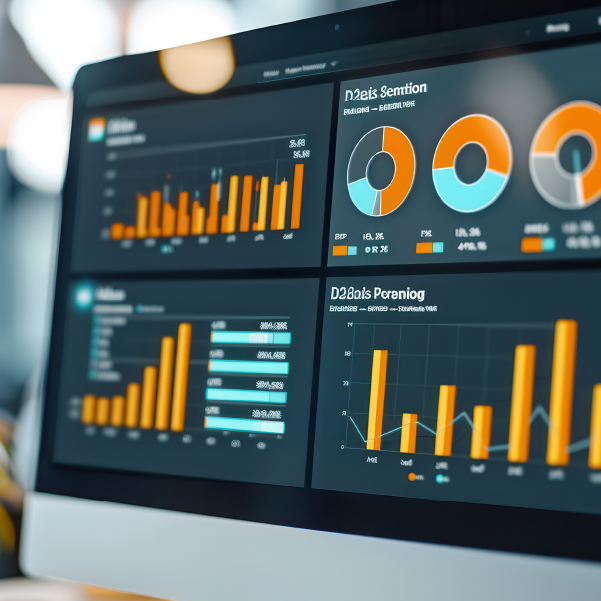Breaking through: How smart data will open doors in academic libraries in 2025.
December 11, 2024
Oghenevwoke Ighure | Territory Manager Libraries & Institutions, UK, Ireland & Central Africa | PressReader
Remember when the idea of putting everything online seemed like the ultimate solution for making academic libraries more accessible? As it turns out, just digitizing resources wasn’t enough to meet the diverse needs of students, researchers, and other users. But here’s where it gets exciting: as we move into 2025, smart data is changing the game by giving librarians tools to truly tailor services to their communities—and the impact has the potential to be transformative.

What do I mean when I say “smart data”, and how does it differ from “big data”?
Organizations, including academic institutions and their libraries, collect massive amounts of data, both unstructured and structured, on a daily basis. That’s big data. But sheer volume isn’t everything.
As data scientist Joo Ann Lee once observed, “Data science isn’t about the quantity of data but rather the quality.”
That’s where the idea of smart data comes in. As Dataversity puts it, “Smart data can be described as big data that has been cleansed, filtered, and prepared for context.”
Smart data, then, is actionable, high-quality data derived from big data analytics, which can provide meaningful insights when effectively managed. Academic libraries can collect and use smart data to enhance their services, improve decision-making, and better serve their users.
There are a number of ways to collect this data, including:
- User activity tracking:
o Integrated Library Systems (ILS): Capture data on borrowing patterns, user preferences, and search behavior.
o Digital footprints: Use web analytics tools to monitor user interactions with the library website and digital repositories.
o RFID & IoT sensors: Track physical resource usage (e.g., books, study spaces, equipment) and traffic patterns in the library.
- Surveys and feedback:
o Use structured feedback mechanisms to gather qualitative data on user satisfaction, needs, and expectations.
- Collaboration with institutional data systems:
o Partner with other departments to collect data on student performance, course enrollment, and research outputs.
- Social media and public interaction data:
o Analyze user engagement on library-managed social media channels.
- External data sources:
o Leverage bibliometric and altmetric data from publishers and external databases.
- Event participation data:
o Track attendance and feedback from library-hosted workshops, seminars, and events.
User patterns reveal meaningful insights
Forward-thinking libraries are already leveraging such data in innovative ways to enhance user experience and success. In 2025 and beyond, the widespread adoption of advanced analytics and artificial intelligence will allow libraries to anticipate user needs more accurately than ever before. Instead of just noting interesting statistics, libraries will delve deeper into user patterns to uncover meaningful insights.
For instance, libraries are recognizing that students access resources at all hours, reflecting diverse schedules and responsibilities. By analyzing usage data, libraries are extending digital services to provide 24/7 support, including chat assistance and specialized guides for late-night researchers. Expect this proactive approach to significantly improve student completion rates and overall satisfaction.

Traditional keyword searches don't work equally well for all users, and by 2025, libraries will have fully integrated adaptive search technologies. These systems learn from diverse search behaviors, accommodating international students and those with learning differences by recognizing alternative search patterns. This inclusivity makes discovery layers smarter and more effective with every query, enhancing accessibility for a broader range of users.
The real magic happens when we use data to anticipate needs before they become barriers. Predictive analytics will play a crucial role in identifying resource gaps before they impact students. For example, noticing that certain student groups frequently switch between devices during research sessions has led to the optimization of interfaces for seamless transitions across phones, tablets, and laptops. In 2025, such seamless user experiences will be standard, contributing to improved academic outcomes.
Smart data supports student retention
Outside of the library, academic institutions can use predictive analytics to provide invaluable data in support of student retention.
For example, as The Chronicle of Higher Education’s “Top 5 Trends in Ed Tech” report tells us, “early-alert analytics” can be particularly valuable for predicting potential challenges students may face by analyzing various data points, such as admissions records, transcripts, and interactions with learning management systems. Let’s say a college observes a trend of sophomores dropping out and identifies that these students lost significant financial or educational support after their first year. Insights like that can help uncover problematic patterns, enabling institutions to deal with them proactively rather than reactively.
Libraries are also discovering that students who use a mix of video and text resources tend to perform better academically. As a result, collections are being reshaped to encourage hybrid learning approaches. By integrating multimedia resources alongside traditional texts, libraries are boosting student engagement and fostering a more dynamic learning environment.
These advancements share a common approach—they're using smart data to open doors, not just track traffic. The shift is subtle but powerful. Instead of merely counting downloads or website visits, libraries are mapping how resources connect to student success. By focusing on outcomes rather than just usage statistics, they're making strategic decisions that have a real impact on their communities.
In 2025, modern discovery systems will be highly adept at learning from every user interaction. They'll recognize and adapt to different research styles, becoming more effective over time. It's like having a personalized assistant who understands your unique needs and preferences. When patterns suggest someone might be struggling to find resources, the system can offer targeted assistance, making the library more responsive and supportive.


With opportunities come challenges
Of course, institutions looking to tap into the power of smart data and learning analytics will need to overcome a few obstacles, including the financial cost of the technology, infrastructure, and skilled people required to make it all work.
There is also the not-so-small matter of privacy and security, which are particularly of concern when it comes to systems that rely on machine learning and AI.
In order to function effectively, such systems require huge quantities of data, which can include sensitive information about users. This raises valid worries about user privacy and data security, and academic institutions and their libraries are not immune. According to IBM, the average data breach at higher education organizations cost over $3 million in 2023.
Growing student concerns about data security and privacy may prompt academic institutions to enhance transparency and offer students greater control over their data, including opportunities to opt out.
As higher-ed information-technology association Educause wrote in its 2024 Horizon Report, “Security risks are not going away, and thus neither will concerns about security and privacy. Institutions will need to continue to drive changes in policies, practices, and professional development focused on safeguarding the collection, storage, ethical use, and dissemination of data.”
The Chronicle of Higher Education reports that a growing number of colleges are adapting their data-governance policies, which determine how their data is collected, stored, and used. The Chronicle’s aforementioned “Top 5 Trends in Ed Tech report” cites Kathe Pelletier, director of the teaching and learning program at Educause, who says that “Data governance is the most critical mechanism on campus” to facilitate the kind of data usage higher ed will need.
“We’re seeing institutions that may have had no data-governance process” or had “a fly-by-night approach to data governance” becoming “much more intentional, inclusive, and structured in how they’re setting up their approaches,” according to Pelletier.
Data-driven decision-making
I could spend hours diving deep into all of the practical challenges of data analytics and the ethical considerations of AI. For now, though, I would rather focus on all of the exciting possibilities these technologies open up for the academic library.
Imagine discovery systems that automatically adjust to each user's research style and needs. I’m not just talking about saved searches—I’m talking about interfaces that evolve to match how you work best.
An AI-powered indexing tool, for example, can analyze a text to identify key concepts and automatically assign relevant keywords. This helps university library users uncover information across various disciplines, enabling them to find more precise and accurate resources to support their research.
AI and machine learning also enable librarians to manage collections more effectively by analyzing data like circulation stats, user demographics, and resource usage. These tools provide insights to guide acquisitions, remove outdated materials, and optimize resource allocation.
By predicting which resources will have the biggest impact on student success, libraries can make smarter decisions about where to invest their limited budgets.
Let user success drive your metrics
For those looking to join this transformation, the key is to observe how different users engage with your resources—not how you think they should use them. Use data to identify and remove barriers, focusing on facilitating success rather than enforcing compliance. Let user success drive your metrics, not just usage numbers.
The future of academic libraries is about using data more intelligently to serve the community better. In 2025, using data isn’t just about counting books or tracking searches. It’s about opening doors, creating opportunities, and making the library work better for everyone.
Smart data has the potential to transform libraries into dynamic environments that proactively support user needs. This approach not only enhances the library experience but also contributes to higher retention and success rates among students. As libraries continue to innovate, they reinforce their role as an essential pillar in the academic ecosystem.
In 2025, smart data will revolutionize academic libraries, enabling them to understand and meet the diverse needs of users like never before. It's about anticipating challenges before they become obstacles and providing personalized support that empowers students and faculty alike.
PressReader Inc.
PressReader is on a mission to enrich and empower curious minds by bringing a universe of quality content within reach. The company builds technology solutions for digital content delivery and consumption, publisher empowerment, content intelligence and brand engagement.
Since 1999, PressReader has pioneered the digital content aggregation and distribution models. Today, PressReader partners with 1,500 of the world’s top publishers to bring over 7,000 newspapers and magazines, in more than 60 languages, to audiences in every corner of the globe. Through partnerships with nearly 8,000 businesses across 150+ countries, PressReader delivers information, entertainment and fresh perspectives to audiences in homes, hotels, airplanes and lounges, libraries, cruise ships, waiting rooms and more. The company also offers individual subscriptions that can be accessed from anywhere.
Hundreds of publishers use the company’s white-labeled solution, Branded Editions, to build their own digital publication platforms and deliver digital content in interactive ways.
About the Author
Oghenevwoke Ighure is the Territory Manager, Libraries & Institutions, UK, Ireland & Central Africa at PressReader. He has over a decade of expertise creating brand-awareness and revenue-generating programs for emerging and growth-stage corporate organizations.
Article references available on request.
The views and opinions expressed in this article are those of the authors and contributors and do not necessarily reflect the official policy or position of Prenax.